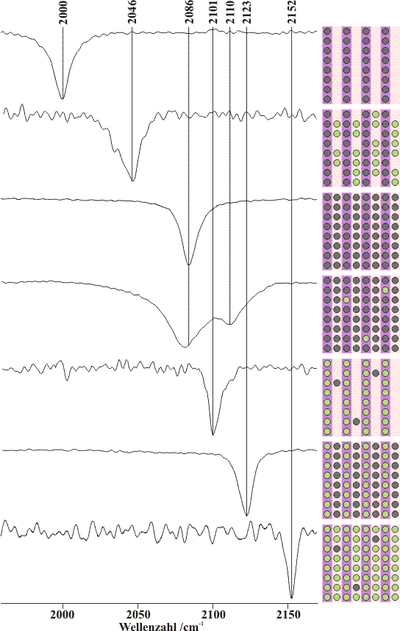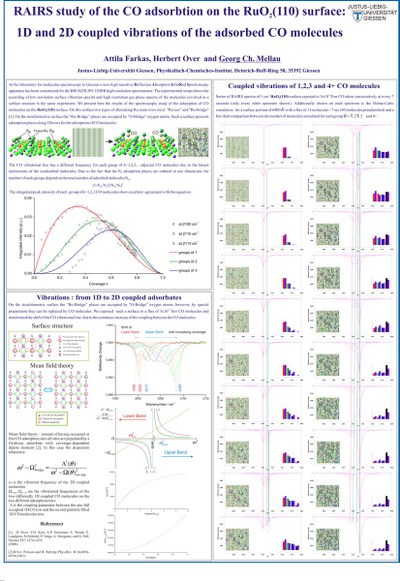Surface Chemistry
Detect directly the vibrations of surface-adsorbed atomic species
The surface of some catalysts such as the RuO2(110) surface, expose usually different types of adsorption sites. For such surfaces it is possible that the reactants of the catalyzed reaction occupy these different types of adsorption sites.
In such a reaction - like the studied model reaction of CO oxidation over the RuO2(110) surface - the reaction mechanism can be surprisingly complex, strongly influenced by the stoichiometric ratio of the reactants and their total pressure.
In order to simulate the reaction steps for this system at a molecular level it is necessary not only to identify the actual elementary (atomic) reaction steps leading to the formation of CO2, but it is also necessary to describe the dynamically changing surface coverage of the reactants. With the help of ab initio kinetic Monte Carlo simulations it has been possible to simulate in detail the surface coverage as well as the most important configurations of adsorbed reactants on the catalyst surface. From an experimental point of view, the main challenge is to find methods that can confirm (or in given case, disprove) the structures resulting from such a theoretical calculation.
Surface spectroscopy is such an important experimental method, since it is able to follow the development of surface structures not only under UHV conditions, but also under a more realistic high pressure regime. It is possible to take in situ surface spectra for the CO molecule in the CO oxidation on the RuO2(110) but these spectra show a complex, evolving pattern of lines. The reason for this is, that the oscillation frequency of the CO molecules depends not only on the adsorption site on the RuO2 catalyst surface, but also on the local environment of neighboring CO molecules and adsorbed O atoms.
We developed an experimental setup and interpretation methods to reduce the complexity of this many-dimensional problem to many one-dimensional problems. These methods allow to assign the observed CO absorption lines to more complex surface coverage patterns. Using the spectroscopic information gained in these experiments, it was possible to experimentally "decrypt" the surface coverage patterns measured in situ during the reaction at relatively high pressures (few mbar). This work is an important contribution to surface chemistry because it has shown clearly that pure ab initio methods without experimental backing easily lead to incorrect conclusions [1]. My work (2007-2011) in the field of surface spectroscopy was performed in the context of my Habilitation work in collaboration with the group of Prof. Dr. Herbert Over. A continuation project was started mid 2015, with the aim of extending our surface spectroscopy experiments to the far infrared. This development would permit to detect directly the vibrations of surface-adsorbed species, like atomic oxygen, or oxygen vibrations (phonons) in the structure of surface oxides grown on transition metals.
[1] A. Farkas, G. Mellau, and H. Over
Novel Insight in the CO Oxidation on RuO2(110) by in-situ Reaction Absorption Infrared Spectroscopy. J. Phys. Chem. C 113, 14341-14355 (2009)


